The best tofu dishes to try in Chinatown (vegan)
Love Chinese food? Why don’t you treat yourself to a self-guided tofu tour.
Even after running a dozen tofu tours in Los Angeles, I’m still amazed by people’s reactions. Their confusion is always the same: this is Chinese food? This is tofu?
If you invest just a little time and money, I guarantee you will find some new favorite foods. Better yet, you’ll get to learn about tofu from the people and culture that created it.
A tofu tour need not be complicated. Here are 4 steps to seamlessly plan and run yours:
1. Search for the following types of Chinese restaurants.
Chinese cuisine is a misnomer. The culture is home to four grand cuisines, each of which is as a big as another national cuisine, four smaller cuisines, and innumerous hyperlocal cooking styles.
(Imagine if each American city were it’s own New Orleans. THAT’S Chinese food.)
Some regional subcuisines are awash in vegan tofu specialties:
Shanghai
Dongbei
Beijing
Sichuan
Hunnan
(By far the best subcuisine for tofu options is Guizhou. Unfortunately, there aren’t many US restaurants. Yunnan is good too but is in a similar situation.)
Besides regional cooking styles, the following specialty eateries, focused on a single dish, tend to have great options:
Spicy Pot 麻辣香锅malaxiangguo
BBQ skewers 串chuan
Hotpot 火锅huoguo
Buddhist restaurants 斋菜zhaicai
While common in the US, Cantonese and Fujianese eateries don’t serve much vegan tofu. Taiwanese food is 80% similar to Fujian.
If you live away from a large Chinese community, you may have pan-Chinese restaurants. These cook mostly Cantonese, American Chinese, and Beijing-style specialties. You will be able to tell as soon as you see their menu…
2. Check out their menus (online).
For each restaurant on your list, scope out their menu. I find this easiest to do on Yelp, as reviewers upload menu photos. If you see any of the following dishes, start scheduling your trip.
Shanghai
Vegetarian Duck 素鸭suya – yuba sheets are marinated in a sweet soy sauce, rolled, steamed, and fried.
Vegetarian Goose 素鹅su’e – yuba sheets are marinated in a sweet soy sauce, rolled around julienned carrots, shiitake, and bamboo, steamed, and fried.
Pressed tofu with malantou 马兰头香干malantou xianggan – a cold salad of peppery malantou (a Chinese leafy green) with minced pressed tofu, salt, msg, and sesame oil.
Red-braised Shanghai tofu 红烧素鸡hongshao suji – Shanghai tofu, known in Chinese as vegetarian chicken, has a custardy mouthfeel and slightly eggy flavor. NOTE: this dish uses oyster sauce, which some vegans don’t mind.
Tofu sheets with fermented mustard greens and edamame 雪菜毛豆百叶xuecai maodou baiye – exactly what the dish sounds like. It’s mild and refreshing. The tofu sheets are silky and luscious in the lightly thickened sauce.
Four happiness kaofu 四喜烤麸sixikaofu – kaofu is a leavened seitan eaten around Shanghai and China’s northwest. It has a bready, spongy mouthfeel. It’s braised in a sweet soy sauce with dried daylily and sometimes shiitake mushrooms. NOTE: kaofu is seitan, not tofu.
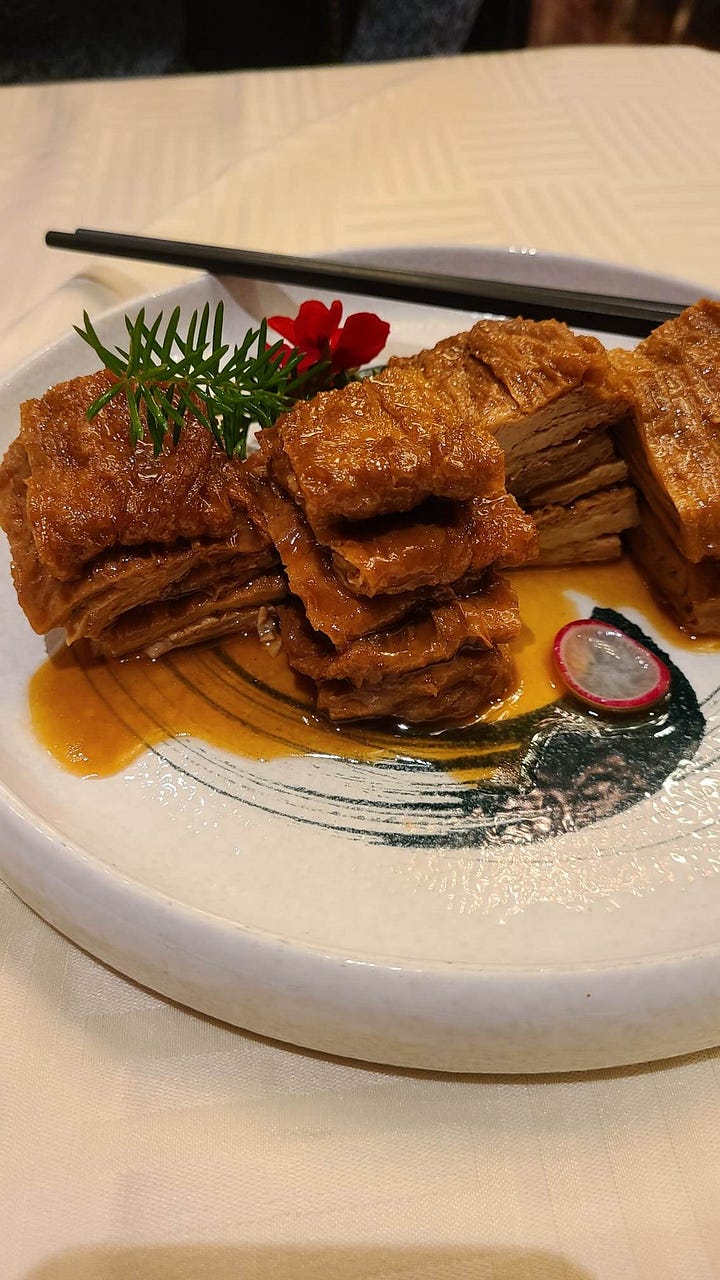


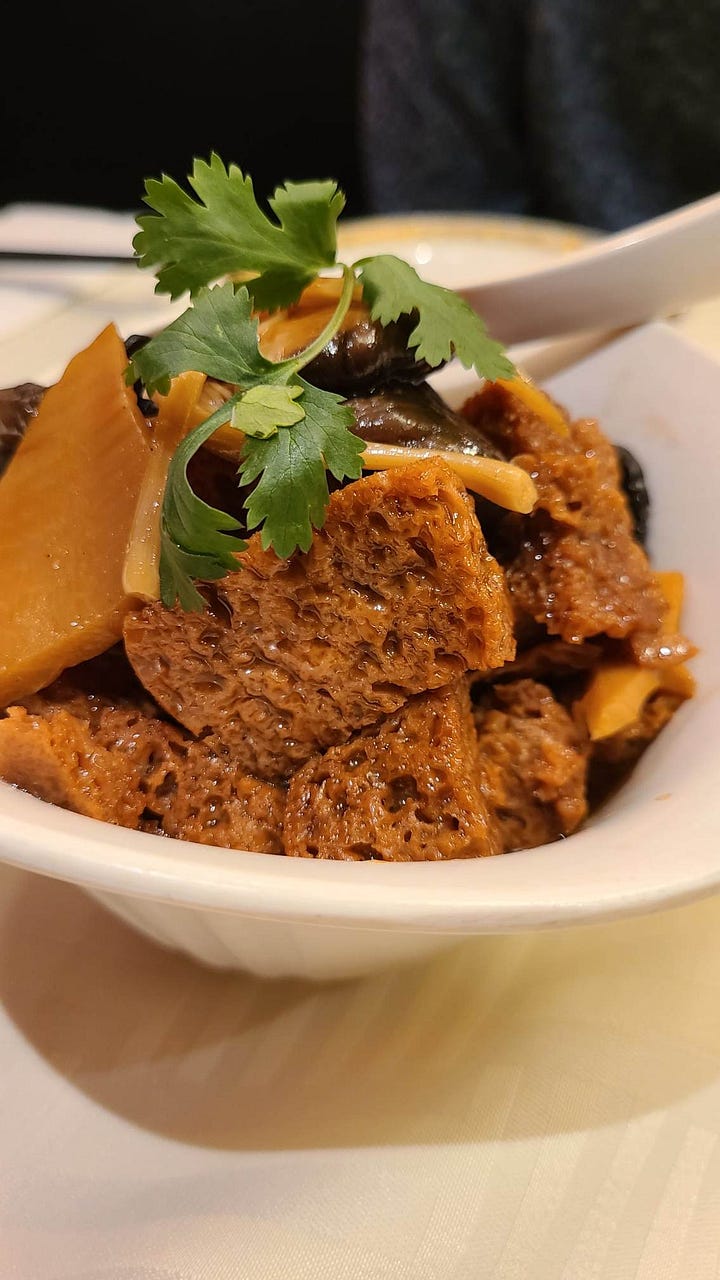
Dongbei
Tofu sheets with green chilies 尖椒干豆腐jianjiao gandoufu – a lightly spicy and smoky stir fry with garlic and five spice. If vegan, clarify no meat 免肉 (it usually comes without.)
Cold shredded tofu noodles 凉拌豆腐丝liangbandoufusi – shredded tofu sheets tossed with a little chili oil, vinegar, garlic, cilantro, and scallions.
Family-style tofu 家常豆腐jiachangdoufu – fried firm tofu with leek, bell pepper, wood ear, etc. Usually in a doubanjiang bean paste. Clarify no meat or oyster sauce (it usually comes without).

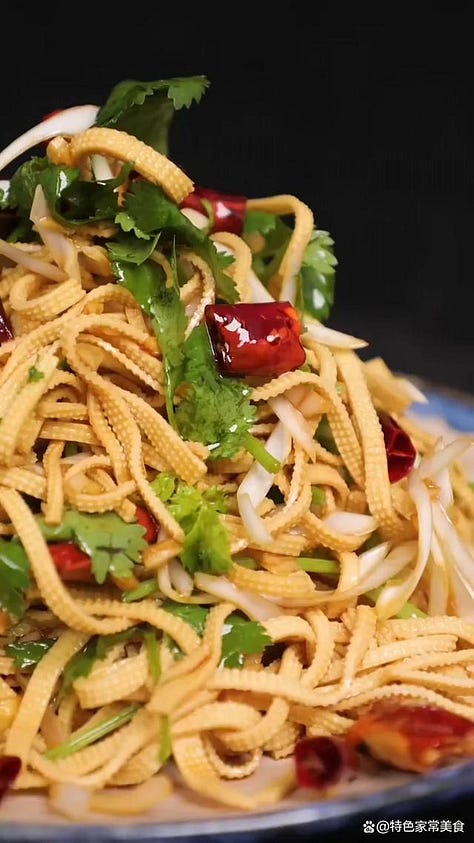

Beijing/northern
Pressed tofu with garlic chives 韭菜香干jiucaixianggan – exactly what it sounds like.
Cold shredded tofu noodles 凉拌豆腐丝liangbandoufusi – shredded tofu sheets tossed with chili oil, vinegar, garlic, cilantro, and scallions.
Dried tofu stick salad 凉拌腐竹liangbanfuzhu – dried tofu sticks tossed with chili oil, vinegar, garlic, cilantro, and scallions.
Family-style tofu 家常豆腐jiachangdoufu – fried firm tofu with leek, bell pepper, wood ear, etc. Usually in a doubanjiang bean paste. Clarify no meat or oyster sauce (it usually comes without).
Sichuan
Spicy pot or dry pot 麻辣香锅 / 干锅 malaxiangguo / ganguo – stir fries based around fragrant chili oil. Clarify no meat or lard (pork is often added). Try spongy tofu 千页豆腐qianyedoufu if they have it.
Mapo tofu 麻婆豆腐mapodoufu – clarify no meat (pork or beef is sometimes added).
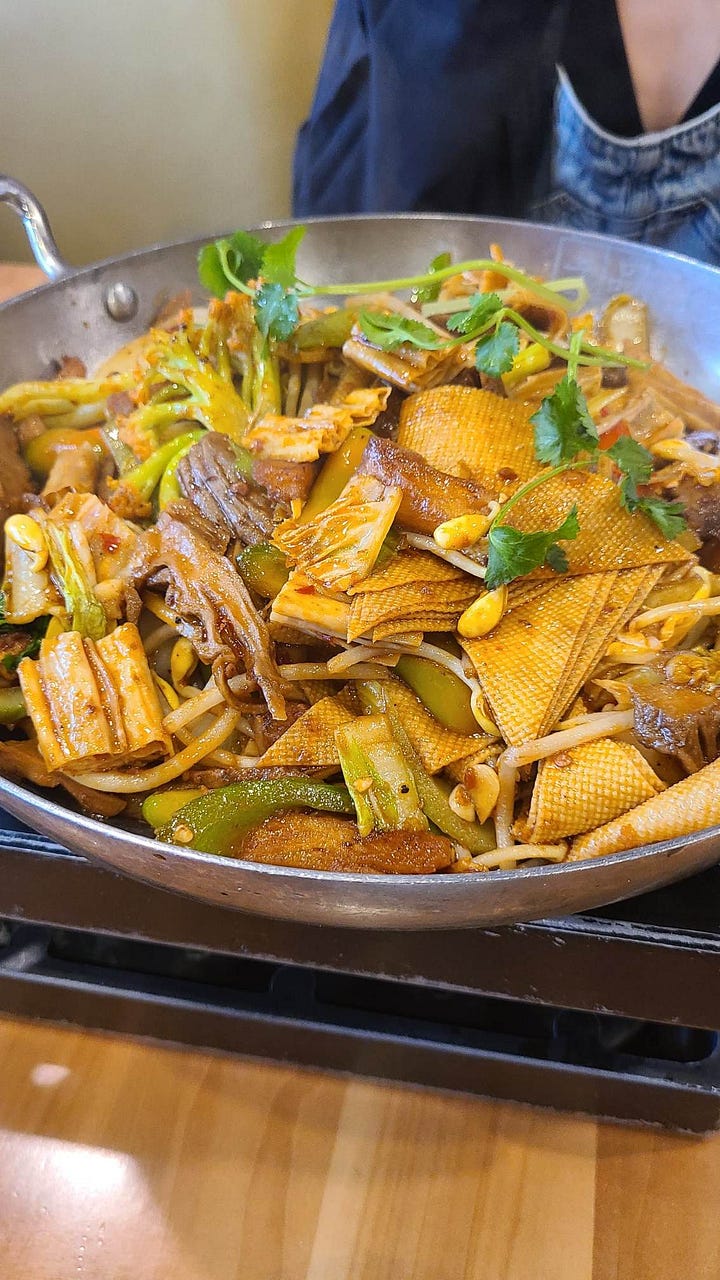
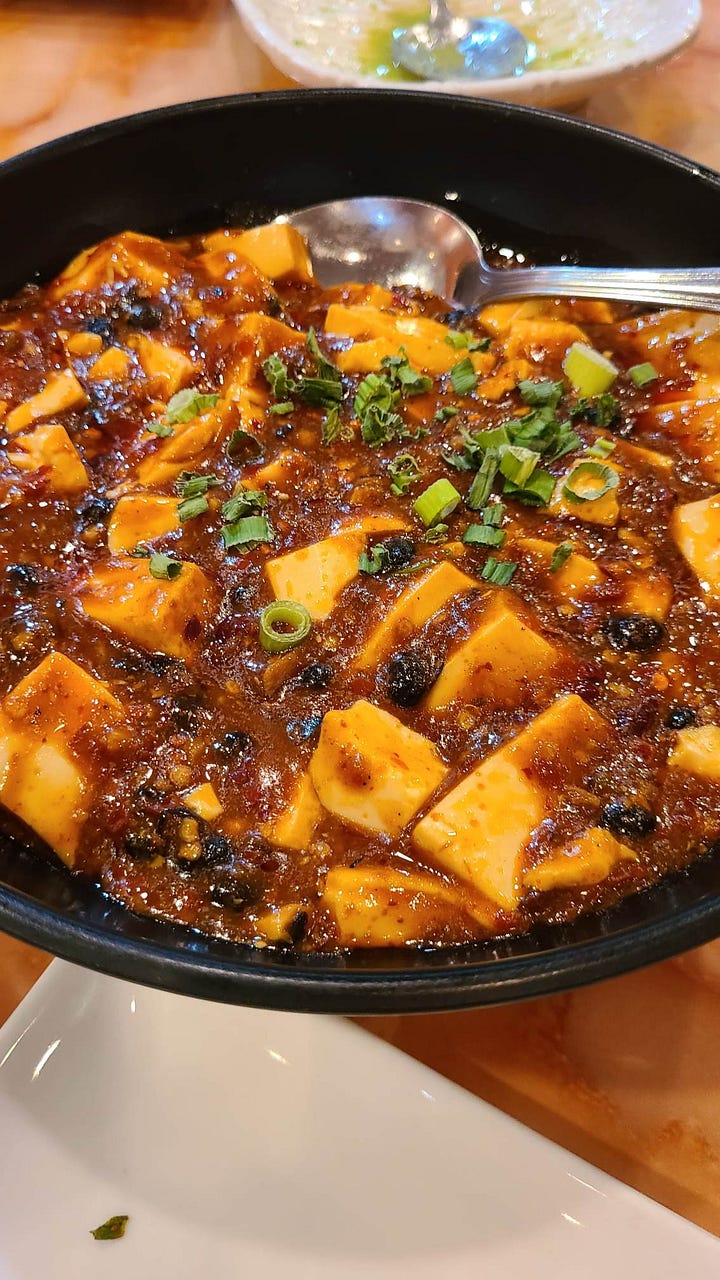
Hunan
Pressed tofu with garlic chives 韭菜香干jiucaixianggan – Hunan versions of this dish include fresh and pickled chilies. Clarify no lard.
Spicy Pot 麻辣香锅malaxiangguo.
These are a la carte stir fries built around fragrant chili oil. Pick your desired ingredients (tofus, seitans, staples, vegetables, fungi…) and spice level (微辣weila is mild). Most places offer >4 varieties of tofu. Try 干豆腐gandoufu tofu sheets, 油豆皮youdoupi tofu skin/yuba, 腐竹fuzhu tofu sticks, 千页豆腐qianyedoufu spongy tofu, and 冻豆腐dongdoufu frozen tofu. If vegan, clarify that they don’t use lard 大油dayou (which is uncommon).
BBQ skewers 串chuan.
Thin skewers (not chunky kebabs!), charcoal grilled, dusted with seasoned chili powders. If vegan, clarify that you can’t eat lard or chicken fat 大油dayou and 鸡油jiyou. (NOTE: some Chinese BBQ restaurants don’t offer vegetable oil, but most do.)
Hotpot 火锅huoguo.
A la carte hot pot restaurants often offer 5+ types of tofu. Try 干豆腐gandoufu tofu sheets, 油豆皮youdoupi tofu skin/yuba, 腐竹fuzhu tofu sticks, 千页豆腐qianyedoufu spongy tofu, 冻豆腐dongdoufu frozen tofu, and 响铃卷xianglingjuan fried yuba rolls. Clarify that your broth is vegan.
Buddhist restaurants 斋菜zhaicai.
These restaurants are 100% vegetarian, but for religious reasons they avoid garlic and scallions, two of the three essential Chinese aromatics. The subcuisine doesn’t taste anything like the bulk of vegan food in China, and it’s relatively bland. Granted, some people love it.
You will probably come across other tofu specialties. Keep your eyes open :)
3. When you order, pay attention to the following:
If you are vegan, confirm several times that everything is plant-based. Veganism isn’t a cultural phenomena in most of China, so many restauranteurs don’t understand the term. The best strategy I’ve found is to ask if the food contains any of the following: meat, fish, seafood, animal fat or lard, and egg. Here’s a script to show in Chinese: 麻烦要纯素,不要任何肉、鱼、海鲜、动物油、鸡蛋、等动物制品。如果点的菜里有什么上面的东西,跟我说一下!谢谢。
The flavors of Chinese food are meant to balance across dishes, not just within. If you can, order a mix of lighter and heavier items, maybe a tofu, a cold appetizer or leafy green, and rice or bread. The risk of just ordering tofu is that the flavors can overwhelm.
Because Chinese food balances across dishes, it’s best eaten with others. Bring two or three friends, if possible!
4. If you love a dish, share it with a friend. And let me know! :)
If you don’t like one restaurant or subcuisine, don’t worry about it! Just try a different one. The cuisines are so different. Keep trying until you fall in love.
And let me know if you taste something delicious that we should add to this list!



